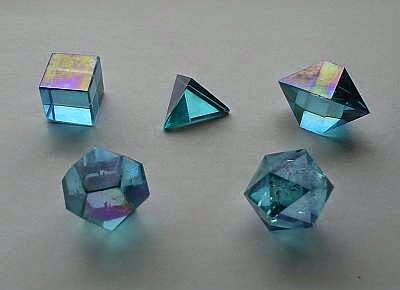Physical appearance of a matter can be called as its state .
Typically there are 4 state of any matter :
1.Solid.
2.Liquid.
3.Gas.
4.Plasma.
Typically there are 4 state of any matter :
1.Solid.
2.Liquid.
3.Gas.
4.Plasma.
The classification :
1.Solids
In a solid the particles (ions, atoms or
molecules) are closely packed together. The forces between
particles are
strong so that the particles cannot move freely but can only vibrate. As a
result, a solid has a stable, definite shape, and a definite volume. Solids can
only change their shape by force, as when broken or cut.
In crystalline solids, the particles (atoms,
molecules, or ions) are packed in a regularly ordered, repeating pattern. There
are various different crystal structures, and the same substance
can have more than one structure (or solid phase). For example, iron has a body-centred
cubic structure at temperatures below 912 °C,
and a face-centred
cubic structure between 912 and 1394 °C. Ice has fifteen known crystal structures, or
fifteen solid phases, which exist at various temperatures and pressures.
Solids can be transformed into liquids by
melting, and liquids can be transformed into solids by freezing. Solids can
also change directly into gases through the process of sublimation, and gases can likewise
change directly into solids through deposition.
Liquid
A liquid is a nearly incompressible fluid that conforms to the shape of its container
but retains a (nearly) constant volume independent of pressure. The volume is
definite if the temperature and pressure are constant. When a solid
is heated above its melting point, it becomes liquid, given
that the pressure is higher than the triple point of the substance.
Intermolecular ( interatomic or interionic) forces are still important, but the
molecules have enough energy to move relative to each other and the structure
is mobile.
This means that the shape of a liquid is not definite but is
determined by its container. The volume is usually greater than that of the
corresponding solid, the best known exception being water, H2O. The highest temperature
at which a given liquid can exist is its critical
temperature.
Gas
The spaces between gas molecules are very big.
Gas molecules have very weak or no bonds at all. The molecules in
"gas" can move freely and fast.
A gas is a compressible fluid. Not only will a gas conform to
the shape of its container but it will also expand to fill the container.
In a gas, the molecules have enough kinetic energy so that the effect of
intermolecular forces is small (or zero for an ideal gas), and the typical distance
between neighbouring molecules is much greater than the molecular size. A gas
has no definite shape or volume, but occupies the entire container in which it
is confined. A liquid may be converted to a gas by heating at constant pressure
to the boiling point, or else by reducing the pressure at constant temperature.
At temperatures below its critical
temperature, a
gas is also called a vapour, and can be liquefied by compression alone without
cooling. A vapour can exist in equilibrium with a liquid (or solid), in which case
the gas pressure equals the vapour pressure of the liquid (or solid).
A supercritical
fluid (SCF) is a gas whose temperature and pressure
are above the critical temperature and critical
pressure respectively. In this state, the distinction
between liquid and gas disappears. A supercritical fluid has the physical
properties of a gas, but its high density confers solvent properties in some
cases, which leads to useful applications. For example, supercritical
carbon dioxide is used to extract caffeine in the manufacture of decaffeinated coffee.
Plasma
In a plasma, electrons are ripped away from their nuclei, forming an electron "sea". This gives it the ability to conduct electricity.
Like a gas, plasma does not have definite shape or volume. Unlike gases, plasmas are electrically conductive, produce magnetic fields and electric currents, and respond strongly to electromagnetic forces. Positively charged nuclei swim in a "sea" of freely-moving disassociated electrons, similar to the way such charges exist in conductive metal. In fact it is this electron "sea" that allows matter in the plasma state to conduct electricity.
The plasma state is often misunderstood, but it is actually
quite common on Earth, and the majority of people observe it on a regular basis
without even realizing it. Lightning, electric sparks, fluorescent
lights, neon
lights, plasma televisions, some types of flame and the stars are all
examples of illuminated matter in the plasma state.
A gas is usually converted to a plasma in one of two ways,
either from a huge voltage difference between two points, or by exposing it to
extremely high temperatures.
Heating matter to high temperatures causes electrons to leave
the atoms, resulting in the presence of free electrons. At very high temperatures,
such as those present in stars, it is assumed that essentially all electrons
are "free", and that a very high-energy plasma is essentially bare
nuclei swimming in a sea of electrons.





